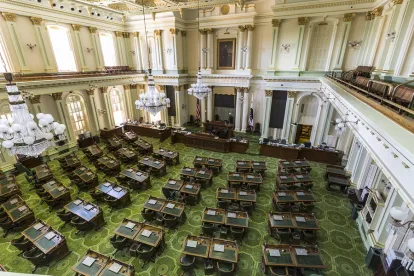Healthcare employers are immediately impacted by two recent developments in federal and California COVID-19 paid leave laws.
First, the Families First Coronavirus Response Act (FFCRA) requires employers with fewer than 500 employees nationwide to provide COVID-19 paid leave to employees; however, the law provides an optional exclusion for “health care provider” employees. The US Department of Labor (DOL) previously defined “health care provider” very broadly, but a New York court struck down the definition, and the DOL has now redefined “health care provider” more narrowly to cover only employees who provide services that are integrated with and necessary to the provision of patient care.
Second, California has passed a COVID-19 supplemental paid sick leave law to fill the FFCRA gap, requiring employers of 500+ employees nationwide and employers of FFCRA-excluded “health care provider” employees to provide COVID-19 supplemental paid sick leave to those employees in the state.
For both changes in the law, quick action is required for compliance.
IN DEPTH
DOL REVISES RULES REGARDING THE FFCRA
FFCRA Overview
The FFCRA applies to companies with fewer than 500 employees and requires those companies to provide paid sick leave to employees who are unable to work for various COVID-19-related reasons. Specifically, a covered employee is entitled to take leave if the employee is unable to work because the employee:
-
Is subject to a federal, state or local quarantine or isolation order related to COVID-19;
-
Has been advised by a healthcare provider to self-quarantine related to COVID-19;
-
Is experiencing COVID-19 symptoms and is seeking a medical diagnosis;
-
Is caring for an individual subject to an order described in (1) or self-quarantine as described in (2);
-
Is caring for a child whose school or place of care is closed (or child care provider is unavailable) for reasons related to COVID-19; or
-
Is experiencing any other substantially similar condition specified by the Secretary of Health and Human Services, in consultation with the Secretaries of Labor and Treasury.
For leave reasons (1), (2) or (3): Employees taking leave are entitled to pay at either their regular rate or the applicable minimum wage, whichever is higher, up to $511 per day and $5,110 in the aggregate (over a 2-week period).
For leave reasons (4) or (6): Employees taking leave are entitled to pay at 2/3 their regular rate or 2/3 the applicable minimum wage, whichever is higher, up to $200 per day and $2,000 in the aggregate (over a 2-week period).
For leave reason (5): Employees taking leave are entitled to pay at 2/3 their regular rate or 2/3 the applicable minimum wage, whichever is higher, up to $200 per day and $12,000 in the aggregate (over a 12-week period).
Ultimately, the FFCRA leave is fully reimbursable to the employer through tax credits.
Employer Option to Exclude “Health Care Providers” from FFCRA Benefits
To ensure that critical health and safety services would not be understaffed during the pandemic, the FFCRA provides an option for employers of “health care provider” employees to exclude such employees from some or all of the paid leave entitlement.
When the law was initially passed, effective April 2020, the DOL issued a temporary rule that defined “health care provider” broadly for this purpose, encompassing essentially any employee whose job responsibilities touched health care in any way. The definition (which has since been ruled invalid) initially included:
-
Anyone employed at any doctor’s office, hospital, healthcare center, clinic, post-secondary educational institution offering healthcare instruction, medical school, local health department or agency, nursing facility, retirement facility, nursing home, home healthcare provider, any facility that performs laboratory or medical testing, pharmacy or any similar institution, employer or entity. This includes any permanent or temporary institution, facility, location or site where medical services are provided that are similar to such institutions;
-
Anyone employed by an entity that contracts with any of the above institutions, employers or entities institutions to provide services or to maintain the operation of the facility;
-
Anyone employed by any entity that provides medical services, produces medical products or is otherwise involved in the making of COVID-19-related medical equipment, tests, drugs, vaccines, diagnostic vehicles or treatments; and
-
Any individual that the highest official of a state or territory, including the District of Columbia, determines is a healthcare provider necessary for that state’s, territory’s or the District of Columbia’s response to COVID-19.
On April 14, 2020, the State of New York filed a lawsuit challenging portions of the DOL’s temporary rule, including the DOL’s definition of “health care provider” (among other provisions). On August 3, 2020, the Southern District of New York ruled that the DOL’s definition of “health care provider” was overly broad and vacated the regulation provision.
DOL’s Revised Definition of “Health Care Provider” for Optional Exclusion from FFCRA Benefits
On September 11, 2020, in response to the adverse ruling, the DOL modified its prior rule in several areas, including to narrow its definition of “health care provider” whom an employer may exclude from being eligible from FFCRA leave. The new rule is effective September 16, 2020.
The revised definition of “health care provider” focuses on the employee’s capability to perform healthcare services, which includes employees who are “employed to provide diagnostic services, preventative services, treatment services, or other services that are integrated with and necessary to the provision of patient care.” The new rule provides examples of who might qualify under this definition, which examples include:
-
Licensed doctors of medicine or osteopathy, nurse practitioners or other healthcare providers permitted to issue certifications for purposes of the Family and Medical Leave Act (FMLA);
-
Nurses, nurse assistants, medical technicians and any other persons who directly provide diagnostic services, preventive services, treatment services or other services that are integrated with and necessary to the provision of patient care;
-
Employees performing services described above under the supervision, order or direction of, or providing direct assistance to, a person described above;
-
Employees who may not directly interact with patients and/or might not report to another healthcare provider, but nonetheless provide services integrated with and necessary to the provision of patient care (g., a laboratory technician who processes test results to support diagnosis);
-
Employees who perform diagnostic services like taking or processing samples, performing or assisting in the performance of X-rays or other diagnostic tests or procedures, and interpreting test or procedure results;
-
Employees who perform preventive services like screenings, check-ups, counseling to prevent illnesses, disease or other health problems;
-
Employees who provide treatment services like surgery or other invasive or physical interventions, administering or providing prescribed mediation and providing or assisting in breathing treatments; and
-
Employees who provide other services integrated with and necessary to diagnostic, preventive or treatment services which if not provided would adversely impact patient care, such as bathing, dressing, hand feeding, taking vital signs, setting up medical equipment or procedures and transporting patients and samples.
Conversely, employees who would not qualify under this new definition (but who may have previously qualified under the DOL’s broader definition) are, for example, employees who are IT professionals, building maintenance staff, HR professionals, cooks, food service workers, records managers, consultants and billers, whoalthough they may provide services related to patient care—are “too attenuated” to be “necessary” components of care so to support an FFCRA exclusion.
Key Takeaway for Healthcare Employers
Under the DOL’s new definition of “health care provider,” likely the majority of healthcare provider employees who were previously excluded from FFCRA benefits will continue to be excludable. However, as the definition has now narrowed somewhat, healthcare companies should review their FFCRA-excluded employee population to determine whether FFCRA leave should be provided prospectively through the FFCRA’s expiration date of December 31, 2020.
CALIFORNIA COVID-19 SUPPLEMENTAL PAID SICK LEAVE (AB 1867) AND ITS APPLICATION TO FFCRA-EXCLUDED HEALTHCARE EMPLOYEES
On September 9, 2020, California Governor Gavin Newsom signed into law Assembly Bill 1867, the California COVID-19 Supplemental Paid Sick Leave Act, which is intended to bridge the gap between the FFCRA and Executive Order No. N-51-20. McDermott’s full briefing on the new California law can be found here.
For healthcare employers with fewer than 500 employees in the United States, the new California COVID-19 supplemental leave law specifically applies to those “health care provider” employees who employers have excluded from FFCRA benefits, and who leave their home or other place of residence to perform work. The new California law also applies to California employees of private employers with 500 or more employees in the United States. For all such employees, the employer must provide California supplemental paid sick leave for various COVID-19 reasons, beginning September 19, 2020.
The California law also contains immediate notice and posting requirements, which include a poster that must be made available to employees by September 19, 2020, as well as printing the amount of available COVID-19 supplemental leave balances on covered employees’ wage statements by the next pay period following September 9, 2020. The California Labor Commissioner’s Office has provided a model poster for employers’ use that can be accessed by clicking here.
Key Takeaway for Healthcare Employers
Private employers with 500+ employees nationwide and with California employees must comply with this new California law. Healthcare employers who have previously excluded their California healthcare provider employees from FFCRA leave benefits must consider whether to continue to exclude such employees from the FFCRA benefits (and comply with the new California law), or to revoke the FFCRA exclusion (and comply with the federal law, in lieu of the California law). Those employers affected by the California law must act immediately to ensure compliance with administrative notice and posting obligations.




 />i
/>i

